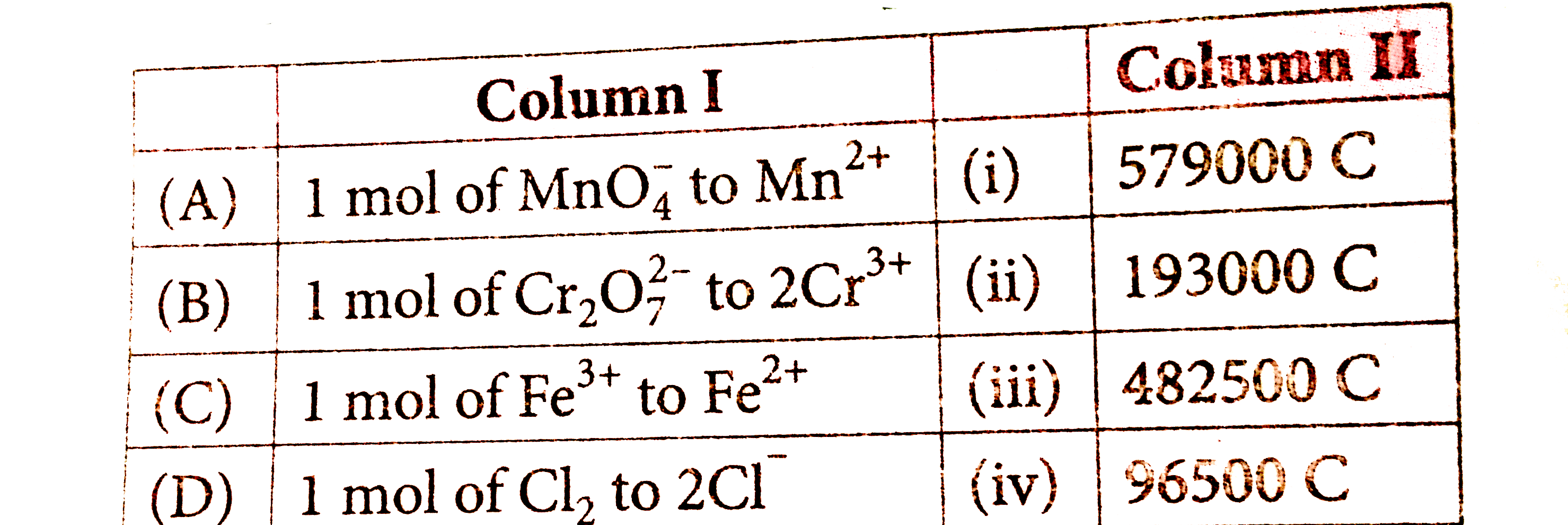Cr2O2−7+14H++6e−→Cr++++7H2O,E∘=1.33V,3×[2I−→I2+2e−],E∘=−0.54V
Find out the value of the equilibrium constant and Gibbs free energy change in the reaction given above.
The correct Answer is:K=1.596×1080,ΔG∘=457.41kJ mol−1
To solve the problem, we need to find the equilibrium constant (K) and the Gibbs free energy change (ΔG) for the given redox reaction. Let's break down the solution step by step.
Step 1: Identify the half-reactions and their standard electrode potentials
We have two half-reactions:
1. Reduction of dichromate ion:
Cr2O2−7+14H++6e−→2Cr3++7H2O,E∘=1.33V
2. Oxidation of iodide ion:
2I−→I2+2e−,E∘=−0.54V
Step 2: Convert oxidation potential to reduction potential
To find the standard reduction potential for the iodide half-reaction, we take the negative of the given oxidation potential:
E∘I2/I−=−(−0.54)=0.54V
Step 3: Calculate the standard cell potential (E°cell)
The standard cell potential is calculated using the formula:
E∘cell=E∘cathode−E∘anode
Here, the cathode is the reduction half-reaction (dichromate) and the anode is the oxidation half-reaction (iodide):
E∘cell=1.33V−0.54V=0.79V
Step 4: Calculate the Gibbs free energy change (ΔG)
The Gibbs free energy change can be calculated using the formula:
ΔG=−nFE∘cell
Where:
- n = number of moles of electrons transferred (6 from the reduction half-reaction)
- F = Faraday's constant (approximately 96500C/mol)
- E∘cell=0.79V
Substituting the values:
ΔG=−6×96500C/mol×0.79V
Calculating this gives:
ΔG=−457410Jor−457.41kJ
Step 5: Calculate the equilibrium constant (K)
Using the relationship between ΔG and K:
ΔG=−RTlnK
We can rearrange this to solve for K:
K=e−ΔG/RT
Where:
- R=8.314J/(mol K)
- T=298K
Substituting the values:
K=e−(−457410)/(8.314×298)
Calculating the exponent:
K=e4574102477.572≈e184.47
Calculating K:
K≈1.511×1080
Final Results
- Gibbs free energy change (ΔG): −457.41kJ
- Equilibrium constant (K): 1.511×1080
We have two half-reactions:
1. Reduction of dichromate ion:
Cr2O2−7+14H++6e−→2Cr3++7H2O,E∘=1.33V
2. Oxidation of iodide ion:
2I−→I2+2e−,E∘=−0.54V
To find the standard reduction potential for the iodide half-reaction, we take the negative of the given oxidation potential:
E∘I2/I−=−(−0.54)=0.54V
The standard cell potential is calculated using the formula:
E∘cell=E∘cathode−E∘anode
Here, the cathode is the reduction half-reaction (dichromate) and the anode is the oxidation half-reaction (iodide):
E∘cell=1.33V−0.54V=0.79V
The Gibbs free energy change can be calculated using the formula:
ΔG=−nFE∘cell
Where:
- n = number of moles of electrons transferred (6 from the reduction half-reaction)
- F = Faraday's constant (approximately 96500C/mol)
- E∘cell=0.79V
ΔG=−6×96500C/mol×0.79V
Calculating this gives:
ΔG=−457410Jor−457.41kJ
Using the relationship between ΔG and K:
ΔG=−RTlnK
We can rearrange this to solve for K:
K=e−ΔG/RT
Where:
- R=8.314J/(mol K)
- T=298K
K=e−(−457410)/(8.314×298)
Calculating the exponent:
K=e4574102477.572≈e184.47
Calculating K:
K≈1.511×1080
- Gibbs free energy change (ΔG): −457.41kJ
- Equilibrium constant (K): 1.511×1080
Topper's Solved these Questions
- ELECTROCHEMISTRYBook:PRADEEPChapter:ELECTROCHEMISTRYExercise:Advanced Problem For Competitions
Explore 17 Videos
- ELECTROCHEMISTRYBook:PRADEEPChapter:ELECTROCHEMISTRYExercise:TEST YOUR GRIP (MUTIPLE CHOICE QUESTION)
Explore 20 Videos
- ELECTROCHEMISTRYBook:PRADEEPChapter:ELECTROCHEMISTRYExercise:Curiosity Question
Explore 5 Videos
- D- AND F-BLOCK ELEMENTSBook:PRADEEPChapter:D- AND F-BLOCK ELEMENTSExercise:IMPORTANT QUESTIONS
Explore 30 Videos
- GENERAL PRINCIPLES AND PROCESSES OF ISOLATION OF ELEMENTS Book:PRADEEPChapter:GENERAL PRINCIPLES AND PROCESSES OF ISOLATION OF ELEMENTS Exercise:Curiosity Questions
Explore 2 Videos
Similar Questions
For Cr2O27+14H++6e−→2Cr3++7H2O
E∘=1.33V.At298k,[Cr2O2−7]=4.5 millimole
[Cr3+]=15 millimole ,E is 1.067 v The pH of the solution is nearly eual to
View SolutionStandard electrode potentials of few half-cell reactions are given below :
MnO−4+8H++5e−→Mn2++4H2OE∘=1.51VCr2O2−7+14H++6e−→2Cr3++7H2OE∘=1.33VFe3++e−→Fe2+E∘=0.77VCl2+2e−→2Cl−E∘=1.36
Based on the above information match the column I with column II and mark the appropriate choice.

View Solution
Knowledge Check
Cr2O2−7+I−→I2+Cr3+
E∘cell=0.79V,E∘Cr2O2−7=1.33V,EoI2 isA0.54VB−0.054VC+0.18VD−0.18VCr2O2−7+I−→I2+Cr3+
E∘cell=0.79V,E∘Cr2O2−7=1.33V,EoI2 isA−0.10VB+0.18VC−0.54VD0.54VFor Cr2O27+14H++6e−→2Cr3++7H2O
E∘=1.33V.At298k,[Cr2O2−7]=4.5 millimole
[Cr3+]=15 millimole ,E is 1.067 v The pH of the solution is nearly eual toA2B3C5D4
For Cr2O2−7(aq)+14H+(aq)+6e−→2Cr3+(aq)+7H2O(aq)
E∘=1.33 V.At[Cr2O2−7]=4.5 millimole,[Cr3+]=15 millimole,Eis1.067 V. The pH of the solution is :
View SolutionIn reaction,
Cr2O2−7+14H++6I−→2Cr3++7H2O+3I2
which element is reduced ?
View SolutionStandard electrode potential data are useful for understanding the suitability of an oxidant in a redox titration. Some half cell reaction and their standard potentials are given below:
MnO−4(aq)+8H+(aq)+5e−→Mn2+(aq)+4H2O(l)E∘=1.51V
Cr2O2−7(aq)+14H+(aq)+6e−→2Cr3+(aq)+7H2O(l),E∘=1.38V
Fe3+(aq)+e−→Fe2+(aq),E∘=0.77V
CI2(g)+2e−→2CI−(aq),E∘=1.40V
Identify the only correct statement regarding quantitative estimation of aqueous Fe(NO3)2
View SolutionStandard electrode potential data are useful for understanding the suitability of an oxidant in a redox titration. Some half cell reaction and their standard potentials are given below:
MnO−4(aq)+8H+(aq)+5e−→Mn2+(aq)+4H2O(l)E∘=1.51V
Cr2O2−7(aq)+14H+(aq)+6e−→2Cr3+(aq)+7H2O(l),E∘=1.38V
Fe3+(aq)+e−→Fe2+(aq),E∘=0.77V
CI2(g)+2e−→2CI−(aq),E∘=1.40V
Identify the only correct statement regarding quantitative estimation of aqueous Fe(NO3)2
View SolutionFor the reaction :
4Al+3O2+6H2O+4OH−→4A1(OH)−4E∘_(cell)=2.73V.
Standard Gibb's free energy change for the reaction is :
View Solution

